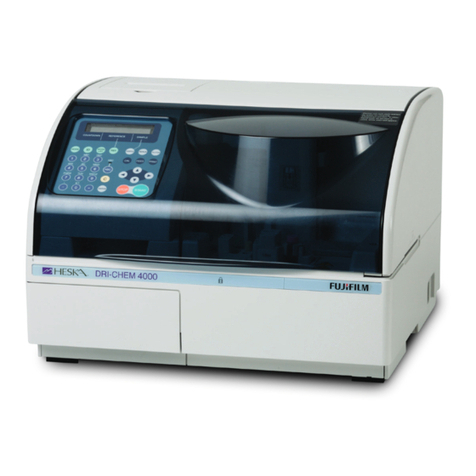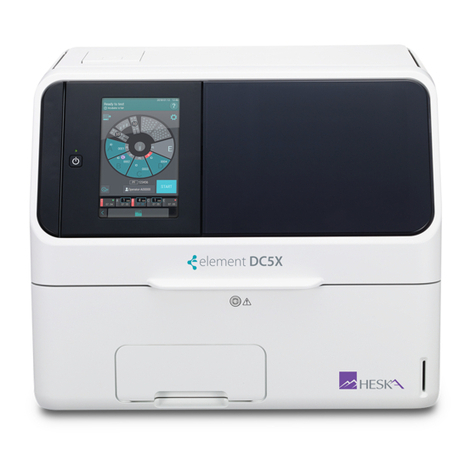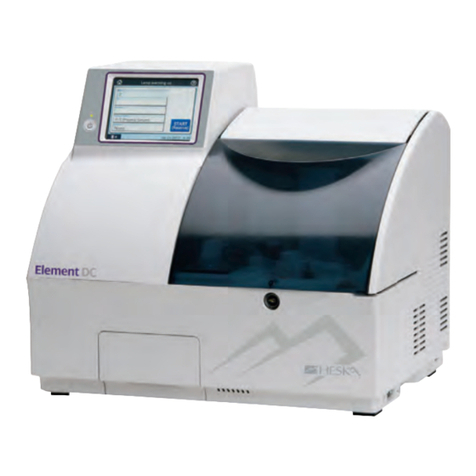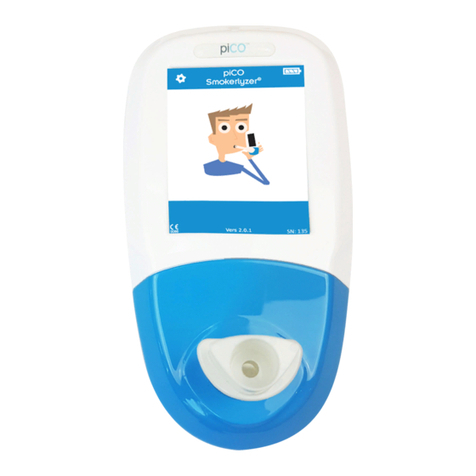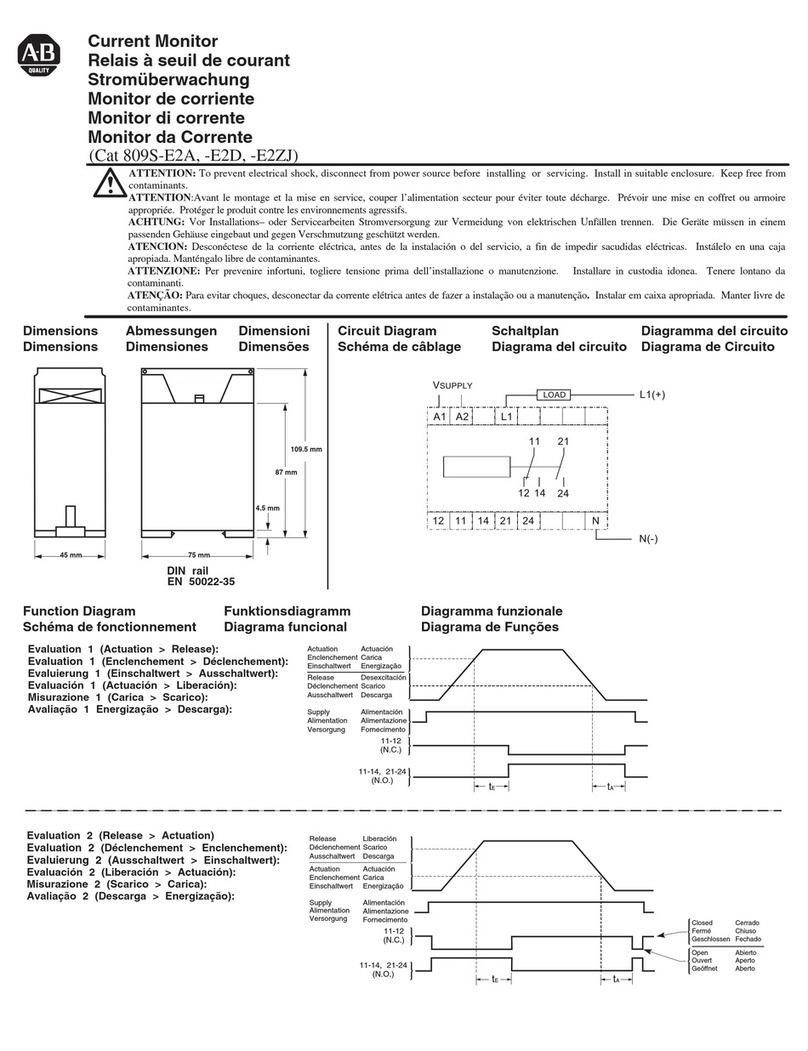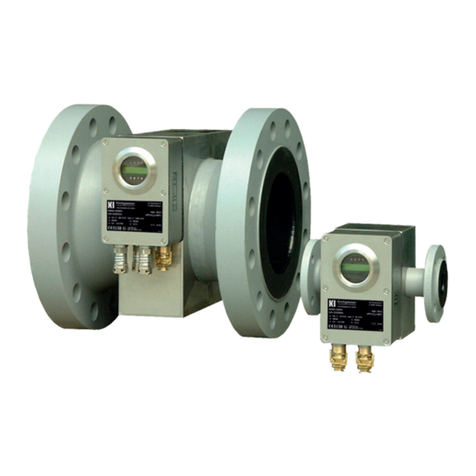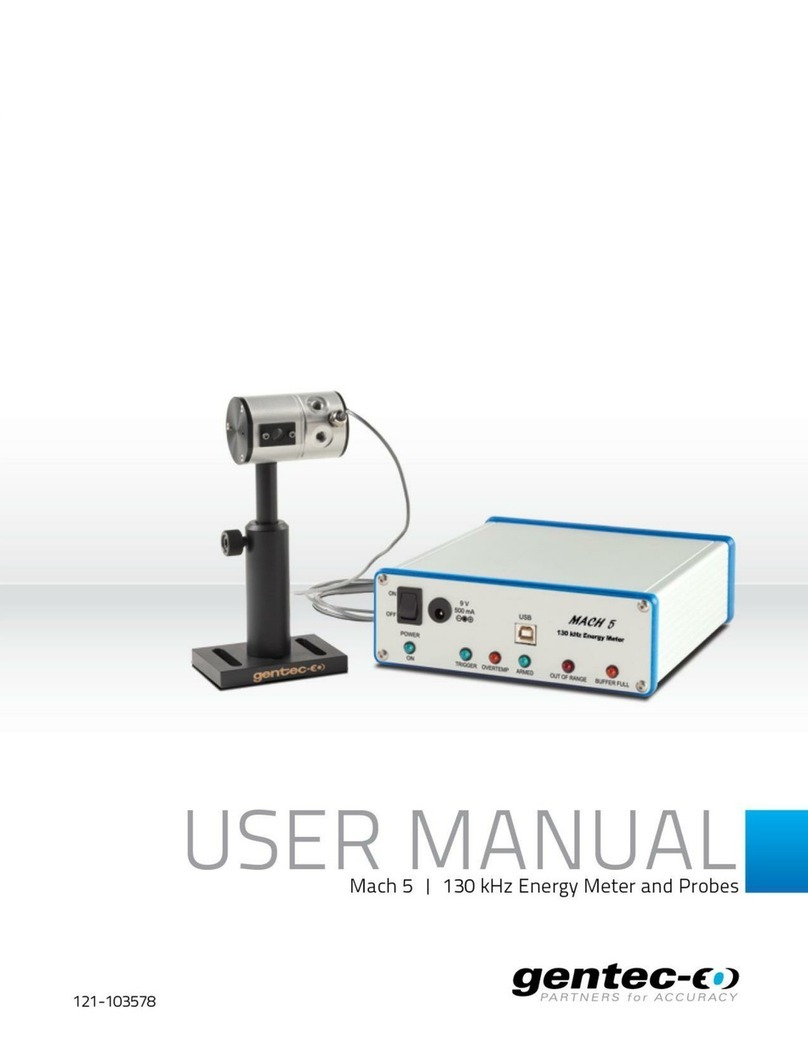Heska Element COAG Manual

Heska Element COAG™
Veterinary Analyzer
Operator’s Guide
November 8, 2017


Contents
About this Guide vii
Technical Support ................................. vii
I. The Heska Element COAG™Veterinary Analyzer 1
1. Introduction 3
1.1. General Information ............................. 3
1.2. Intended Use of the Heska Element COAG™Analyzer .......... 3
1.3. Basic Operating Principles ......................... 4
1.4. Features of the Heska Element COAG™Analyzer ............ 4
1.4.1. Symbols Used in Labeling ..................... 5
1.4.2. Intended Use of the Heska Element COAG™Cartridges . . . . . 5
2. System Description and Setup 7
2.1. User Information and Precautions ..................... 7
2.2. Unpacking .................................. 8
2.3. Main Components ............................. 9
2.3.1. The Heska Element COAG™Analyzer .............. 9
2.3.2. The Heska Element COAG™Cartridge .............. 11
2.4. Setup .................................... 11
3. Configuring the Heska Element COAG™Analyzer 13
3.1. The Home Screen ............................. 13
3.2. Configuration of the Heska Element COAG™Analyzer . . . . . . . . . . 14
3.2.1. Clinic Info .............................. 15
3.2.2. Software Version/Upgrade ..................... 16
3.2.3. Copy Data from the Analyzer ................... 17
3.2.4. Customize ............................. 18
3.2.5. Regional Setup ........................... 19
3.2.5.1. Set Date ......................... 20
3.2.5.2. Set Time ......................... 22
3.2.5.3. Set the Date Format ................... 23
3.2.5.4. Set the Language .................... 24
3.2.5.5. Set the Keyboard Layout ................ 25
iii

Contents
3.2.6. Connections ............................ 26
3.2.6.1. Printer .......................... 28
3.2.6.2. Network ......................... 29
3.2.7. Quality Assurance ......................... 32
3.2.7.1. Calibration ........................ 32
3.2.7.2. Analyzer Self Test .................... 34
3.2.8. Screen Saver ............................ 34
3.2.8.1. Load Pictures ...................... 35
4. Memory Database 37
4.1. Viewing Test Results ............................ 37
4.2. Performing a Database Search ....................... 38
4.2.1. Search by Patient ID ........................ 39
4.2.2. Search by Sample ID ........................ 39
4.2.3. Search by Date ........................... 40
4.2.4. Search by Test Type ........................ 40
5. Maintenance and Support 41
5.1. Routine Maintenance ............................ 41
5.2. Cleaning the Outer Shell .......................... 41
5.3. Cleaning the Cartridge Slot and Air Filter ................. 41
5.4. Service ................................... 42
5.5. Disposal of the Heska Element COAG™Analyzer ............. 42
6. Troubleshooting 43
6.1. Technical Support .............................. 43
6.2. Problems That Give No Advisory Messages ................ 43
6.3. List of Advisories .............................. 43
6.4. Screen Calibration ............................. 45
II. The Heska Element COAG™Test Portfolio 47
7. PT/aPTT Combination Test 49
7.1. Blood Coagulation ............................. 49
7.2. Test Specifications ............................. 50
7.3. Test Requirements ............................. 53
7.3.1. Materials and Equipment ...................... 53
7.3.2. Blood Sample Preparation ..................... 53
7.4. Limitations .................................. 54
7.5. Test Procedure ............................... 54
8. Equine Fibrinogen Test 57
8.1. Fibrinogen Testing ............................. 57
iv

Contents
8.2. Test Specifications ............................. 58
8.3. Test Requirements ............................. 60
8.3.1. Materials and Equipment ...................... 60
8.3.2. Centrifuge .............................. 60
8.3.3. Sample Preparation ........................ 61
8.4. Limitations .................................. 62
8.5. Test Procedure ............................... 63
9. Canine Fibrinogen Test 67
9.1. Fibrinogen Testing ............................. 67
9.2. Test Specifications ............................. 68
9.3. Test Requirements ............................. 70
9.3.1. Materials and Equipment ...................... 70
9.3.2. Centrifuge .............................. 70
9.3.3. Sample Preparation ........................ 70
9.4. Limitations .................................. 72
9.5. Test Procedure ............................... 73
10.Canine DEA 1 Blood Typing 77
10.1. Canine Blood Typing ............................ 77
10.1.1. Blood Groups ............................ 78
10.1.2. Blood Transfusion ......................... 78
10.2. Test Specifications ............................. 78
10.3. Test Requirements ............................. 80
10.3.1. Materials and Equipment ...................... 80
10.3.2. Blood Sample Preparation ..................... 81
10.4. Limitations .................................. 81
10.5. Test Procedure ............................... 82
11.Feline A, B and AB Blood Typing 87
11.1. Feline Blood Typing ............................. 87
11.1.1. Feline Blood Groups ........................ 87
11.1.2. Blood Transfusion Risks ...................... 88
11.1.3. Mating risks ............................. 88
11.2. Test Specifications ............................. 88
11.3. Test Requirements ............................. 90
11.3.1. Materials and Equipment ...................... 90
11.3.2. Blood Sample Preparation ..................... 91
11.4. Limitations .................................. 91
11.5. Test Procedure ............................... 92
Bibliography 95
v


About this Guide
This Operator’s Guide is written for Heska Element COAG
™
Analyzers with software
newer than version
03102017_0848
. Please refer to
Section 3.2.2
for information regard-
ing finding the version of the software currently installed on the analyzer and instructions
to upgrade to the newest version.
The following symbols and convention are used in this guide:
Bold Used for menu, command and keyboard selections and screens you will see.
Italics
Used for emphasis.
iHelpful information about a particular topic.
!Important information to prevent problems and ensure that you are successful
in using the instrument.
Technical Support
For any inquiries about the instrument or use of the test cartridges, contact your Distributor
or Heska Corporation Customer Support.
See contact information below:
Heska Corporation
3760 Rocky Mountain Avenue
Loveland, Colorado 80538
USA
T800-464-3752
Íwww.heska.com
vii


Part I.
The Heska Element COAG™
Veterinary Analyzer


Chapter 1
1. Introduction
1.1. General Information
The Heska Element COAG
™
Analyzer is an innovative specialty Analyzer developed
and used exclusively for veterinary diagnostics.
The Heska Element COAG
™
Analyzer enables veterinarians to perform automated
in-clinic specialty testing using disposable cartridges. The Heska Element COAG
™
Analyzer’s operation is based on light absorption.
The Heska Element COAG
™
Analyzer contains microprocessors and LED optical el-
ements to control all testing and analytical functionalities. The operator controls the
Analyzer’s functions through a 7-inch color touch screen. An open slot in the front of the
Analyzer allows the insertion of a cartridge, and guides the test cartridge into place for
analysis.
The Heska Element COAG
™
Analyzer test cartridge has two optical detection windows
and is preloaded with dry reagents specific to the tests. All blood clot formations or
reactions occur within the test cartridge.
Test results are displayed on screen, and are automatically stored in the instrument’s
memory database for later retrieval. The results can be printed to an optional USB printer
or exported to a central Laboratory Information System (LIS). An external keyboard can
also be connected to USB ports at the back of the instrument, if so desired.
1.2. Intended Use of the Heska Element COAG™Analyzer
The Heska Element COAG
™
Analyzer provides quantitative in-vitro determination of:
•Fibrinogen
•PT (Prothrombin Time)
•aPTT (activated Partial Thromboplastin Time)
•DEA 1 Canine Blood Typing
•Feline A & B Blood Typing
3

1. Introduction
!
If the Heska Element COAG
™
Analyzer is used in any way other than that
described in this manual, the Analyzer may not operate as intended, may
produce inaccurate or no results, and may pose a safety hazard. Only use
approved Heska Element COAG™cartridges with the Analyzer.
1.3. Basic Operating Principles
The Heska Element COAG
™
Analyzer’s operation is based on one-time-use test car-
tridges containing micro channels and test-specific reagents. Samples added to the
Heska Element COAG
™
cartridges flow through micro channels in the cartridge where it
reacts with test-specific reagents. Light passing through the optical detection window on
the cartridge is absorbed by the sample in the channels. The Analyzer measures how
much light is absorbed and automatically calculates the test results, which are displayed
on screen and stored in the Analyzer’s database. No interaction is needed or required
by the user during the analysis.
1.4. Features of the Heska Element COAG™Analyzer
•Large, 7-inch color touchscreen
•Easy-to-use touchscreen controls
•Small sample size (100 µL or less)
•Fast and accurate point-of-care results
•Simple and user-friendly operation
•Continuous internal self-test monitoring during operation
•Small footprint
•
Up to 1000 test results can be stored and retrieved from the instrument’s results
database
•Allows Patient and Sample ID input (optional)
•LIS-interface
4

Chapter 1
1.4. Features of the Heska Element COAG™Analyzer
1.4.1. Symbols Used in Labeling
!
E
Caution, risk of danger
(see accompanying warn-
ing text)
Caution, risk of electric shock
Alternating Current
Direct Current
USB Connection
1.4.2. Intended Use of the Heska Element COAG™Cartridges
The Heska Element COAG
™
cartridges are exclusively intended for use with the Heska
Element COAG™Analyzer. Utilizing it with other instruments is not advisable.
•
Each Heska Element COAG
™
cartridge is clearly labeled with test type and individ-
ually packed in a sealed pouch with a desiccant bag to protect it from moisture.
•
Once the pouch has been opened, the Heska Element COAG
™
cartridge must be
used within the time limit stated on the package insert.
•
Do not use the cartridge after its expiration date since it is only stable until the date
stamped on the pouch. Using it after the duration date can result in inaccurate test
results.
•
Do not store the Heska Element COAG
™
cartridge outside the temperature range
stated on the package insert:
–Fibrinogen Test (36 °F to 46 °F) / (2 ◦C to 8 ◦C)
–PT/aPTT Combination Test (36 °F to 46 °F) / (2 ◦C to 8 ◦C)
–DEA 1 Canine Blood Typing Test (36 °F to 77 °F) / (2 ◦C to 25 ◦C)
–Feline A & B Blood Typing Test (36 °F to 77 °F) / (2 ◦C to 25 ◦C)
•
The Heska Element COAG
™
cartridges should be at room temperature before use,
i.e., between
59 °F
to
86 °F
(
15 ◦C
to
30 ◦C
). Exposing the cartridge to extreme
temperatures impairs its accuracy.
•
Used cartridges, pipettes and collection tubes are considered potentially infectious.
Dispose them off properly in accordance with the policies and regulations practiced
at the place of operation.
5

1. Introduction
•
When using the Heska Element COAG
™
cartridges, all biohazard safety guide-
lines pertaining to handling and disposal of animal blood samples must be strictly
followed.
!
Do not reuse cartridges. All Heska Element COAG
™
cartridges are for single
use only. Once used, the cartridge should be disposed of in accordance with
the safety guidelines at the place of operation.
6

Chapter 2
2. System Description and Setup
2.1. User Information and Precautions
Please read the instructions in this Operator’s Guide carefully before using the Heska
Element COAG
™
Analyzer, and follow all instructions and warnings and keep it handy
for future references.
The Heska Element COAG
™
Analyzer and its cartridges are exclusively intended for
veterinary use. If the Heska Element COAG
™
Analyzer is used in a manner not specified
by the manufacturer, the protection provided by the instrument may be impaired.
Observe the following:
•
Attempting to open or dismantle the instrument can cause electric shock and will
void the warranty.
•
Protect the instrument from being wet, whether it is exposure to wet locations or to
rain or snow.
•
Use only the power supply that is provided together with the instrument. Use of
any other power supply will damage the instrument, thus, voiding the warranty.
•
It is highly recommended that the power supply be disconnected or the instrument
turned off when not in use.
•
The power supply must be connected to a main power outlet that is grounded and
of a quality normally found in hospitals, domestic and commercial environments.
•
Do not expose the Heska Element COAG
™
Analyzer to extreme temperatures:
below
59 °F
(
15 ◦C
) and above
86 °F
(
30 ◦C
). Never expose the Heska Element
COAG™Analyzer near a heat source nor expose it to direct sunlight.
•
It is strongly recommended to inspect the Heska Element COAG
™
Analyzer regu-
larly for damages. If damaged, disconnect instantly and contact Technical Support
for assistance.
•
If the Heska Element COAG
™
Analyzer is accidentally dropped, immediately contact
Technical Support. In this case, no test should be performed until it has been
serviced by authorized personnel.
7

2. System Description and Setup
•
Do not use non-Heska Element COAG
™
cartridges with the Heska Element COAG
™
Analyzer. A non-Heska Element COAG
™
cartridge will not operate in the instrument
and will only generate an error message when used.
•
Before inserting the cartridge, make sure that there are no foreign objects in the
cartridge slot. Test cartridges should slide in easily into the cartridge slot. No force
is needed in the insertion.
•
Do not use excessive force or sharp objects on the Analyzer’s sensitive touch
screen. A light tap is sufficient.
•
The detachable power supply cord set and appliance inlet of the external power
supply are considered as the disconnecting device.
•
The USB interface connector of the Heska Element COAG
™
Analyzer must only
be connected to SELV circuits.
•
The LAN connector must only be connected to 10Base-T/100Base-TX circuits.
External computing devices connected to the USB and LAN interface connectors
have to comply with the standard UL60950 for US and Canada, and IEC60950 for
other countries.
•
Network/USB cables connected to Heska Element COAG
™
Analyzer should not
be more than 3 meters long.
2.2. Unpacking
When unpacking the instrument, be sure that the following guidelines are followed:
•Remove the Heska Element COAG™Analyzer from the shipping carton.
•
Place the Analyzer on a leveled surface relatively free of animal hair, dust and
other contaminants.
•Do not place near a window or a heat source.
Make sure that you received the following components:
•Heska Element COAG™Analyzer
•Sealing Cartridge
•Power supply with cord
•Power cord
•Heska Element COAG™Diagnostic System Operator’s Guide.
•
Quick Guide for each of the tests in the Heska Element COAG
™
test portfolio,
see Part II.
8

Chapter 2
2.3. Main Components
2.3. Main Components
2.3.1. The Heska Element COAG™Analyzer
The main components of the Heska Element COAG
™
Analyzer are shown in
Figure 2.1
and an overview of the Analyzer’s technical specifications is given in Table 2.1.
The Heska Element COAG
™
Analyzer has a 7-inch touch screen which serves as the
main interaction point between the operator and the instrument itself. The instrument has
a cartridge slot located on the front where the Heska Element COAG
™
test cartridges are
inserted. The power supply connector is located at the back of the instrument together
with the LAN port and two USB 2.0 ports. An on/off button is located at the rear of the
instrument as well.
Touch
Screen
Cartridge
Slot
On/Off
Button
USB 2.0
Ports
LAN
Port
Power
Supply
Connector
Figure 2.1: Front (left) and back (right) view of the Heska Element COAG™Analyzer.
9

2. System Description and Setup
Table 2.1: Technical Specifications for the Heska Element COAG™Analyzer.
Operating Environment Indoor use only
Temperature 59 °F to 86 °F (15 ◦C to 30 ◦C)
Max. Relative Humidity 80 %
Max. Altitude 9843 ft (3000 m)
Pollution Degree 2
Others
Mode of Operation Continuous
Instrument’s placement minimum dis-
tance from the nearest object
15 cm/6 in
Power Supply
Input 100 V AC to 240 V AC
(fluctuations < 10 % of nominal voltage)
1.5 A
50 Hz to 60 Hz
Output 12 V DC
6.67 A
Instrument
Input 12 V DC
2.7 A
Power Consumption 32.4 W
Transient Overvoltage Category II of IEC 60364-4-443
Instrument Input Connections 12 V DC Power Supply
Instrument Input and Output Connec-
tions
LAN and USB 2.0
10

Chapter 2
2.4. Setup
2.3.2. The Heska Element COAG™Cartridge
Figure 2.2
shows a typical Heska Element COAG
™
test cartridge. The Heska Element
COAG
™
cartridge has a label that indicates the kind of test the cartridge performs. It
has a sample well where the sample is being added or placed.
Optical
detection
windows
Sample
well
Cartridge
label
Figure 2.2: Heska Element COAG™cartridge.
Sample added to the Heska Element
COAG
™
cartridge is drawn by capil-
lary force into the cartridge where it
is mixed with reagents. The microflu-
idic based design makes it possible
to have two independent detection
windows on the cartridge with a sam-
ple volume below
100 µL
. Light pass-
ing through the two optical detection
windows is absorbed by the sample.
Test results are determined by using
the measurement technology of light
absorbance.
The cartridge contains the reagents
necessary to perform the tests. The
user only needs to insert the cartridge
in the instrument’s cartridge slot and
follow the on-screen instructions. A
small sample volume is enough to carry out the tests. Just add an adequate amount of
sample and see the results after a few minutes.
2.4. Setup
Before setting up the Heska Element COAG™Analyzer:
•Make sure that the room temperature is between 59 °F to 86 °F (15 ◦C to 30 ◦C).
•
If the instrument has been stored outside the aforementioned temperature range,
let the instrument reach room temperature prior to use.
•
When the abovementioned factors have been met, place the Heska Element
COAG
™
Analyzer on a clean, flat, and stable vibration free surface at least
15 cm
(6 in) from the nearest object.
•Plug the Heska Element COAG™Analyzer into the power supply.
•
Turn on the instrument by touching the power button at the back of the instrument.
11
Table of contents
Other Heska Measuring Instrument manuals
Popular Measuring Instrument manuals by other brands
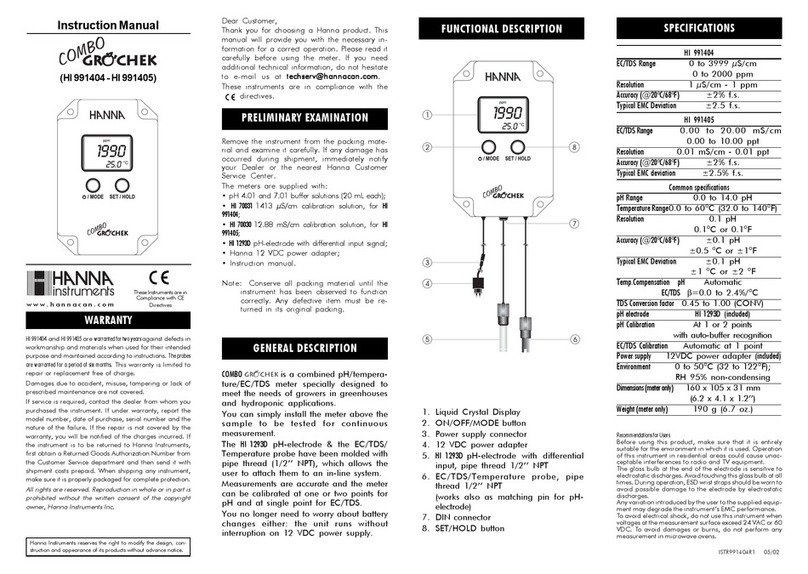
Hanna Instruments
Hanna Instruments Combo Grochek HI 991404 instruction manual

Hach
Hach CA610 user manual
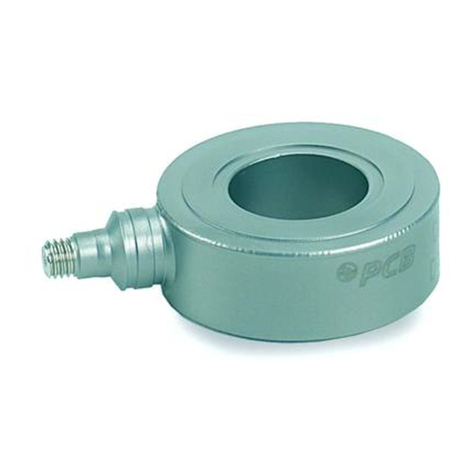
PCB Piezotronics
PCB Piezotronics 214B Installation and operating manual
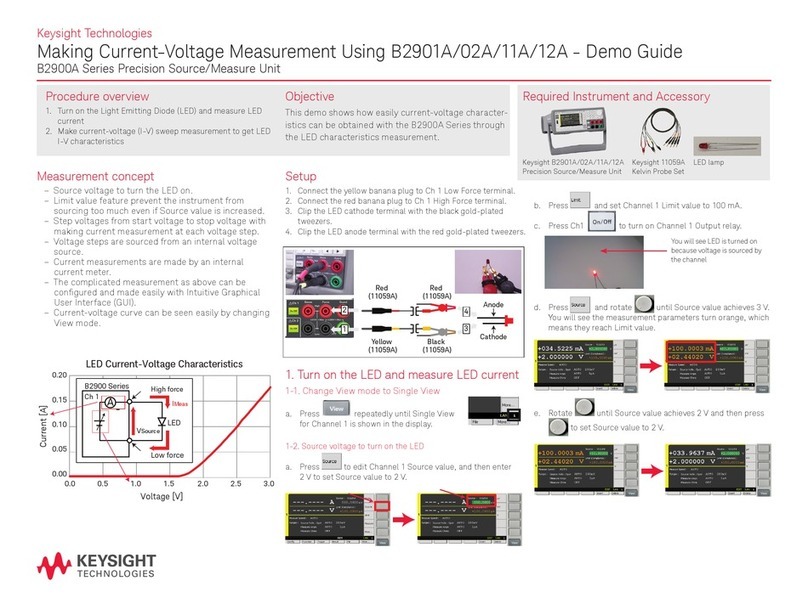
Keysight Technologies
Keysight Technologies B2900A Series Demo guide
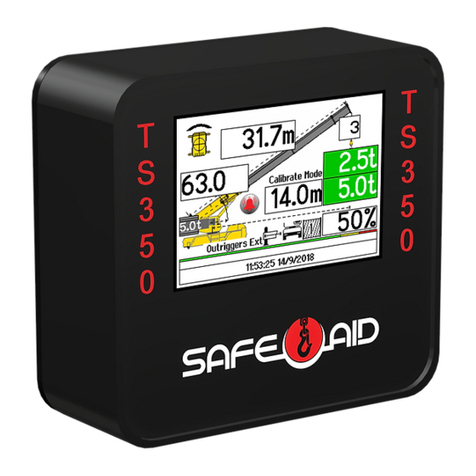
ELEC-MECH
ELEC-MECH SAFE-AID TS350 Operator's manual

Metrohm
Metrohm NIRS DS2500 manual
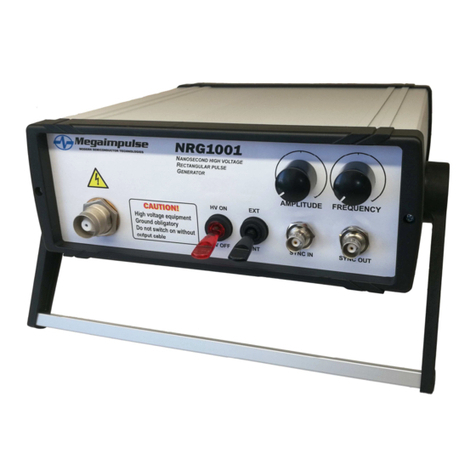
Megaimpulse
Megaimpulse NRG1001 user manual

Quantum Data
Quantum Data 980 user guide
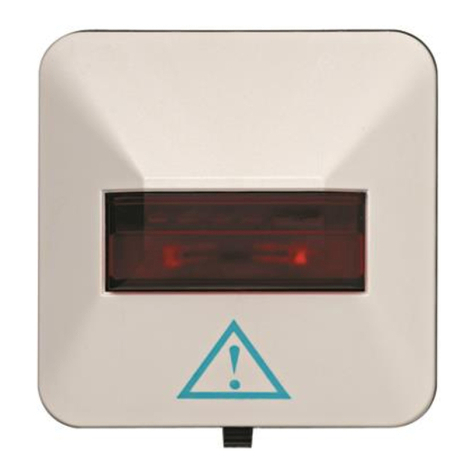
Siemens
Siemens AlgoRex DJ1191-Ex installation instructions
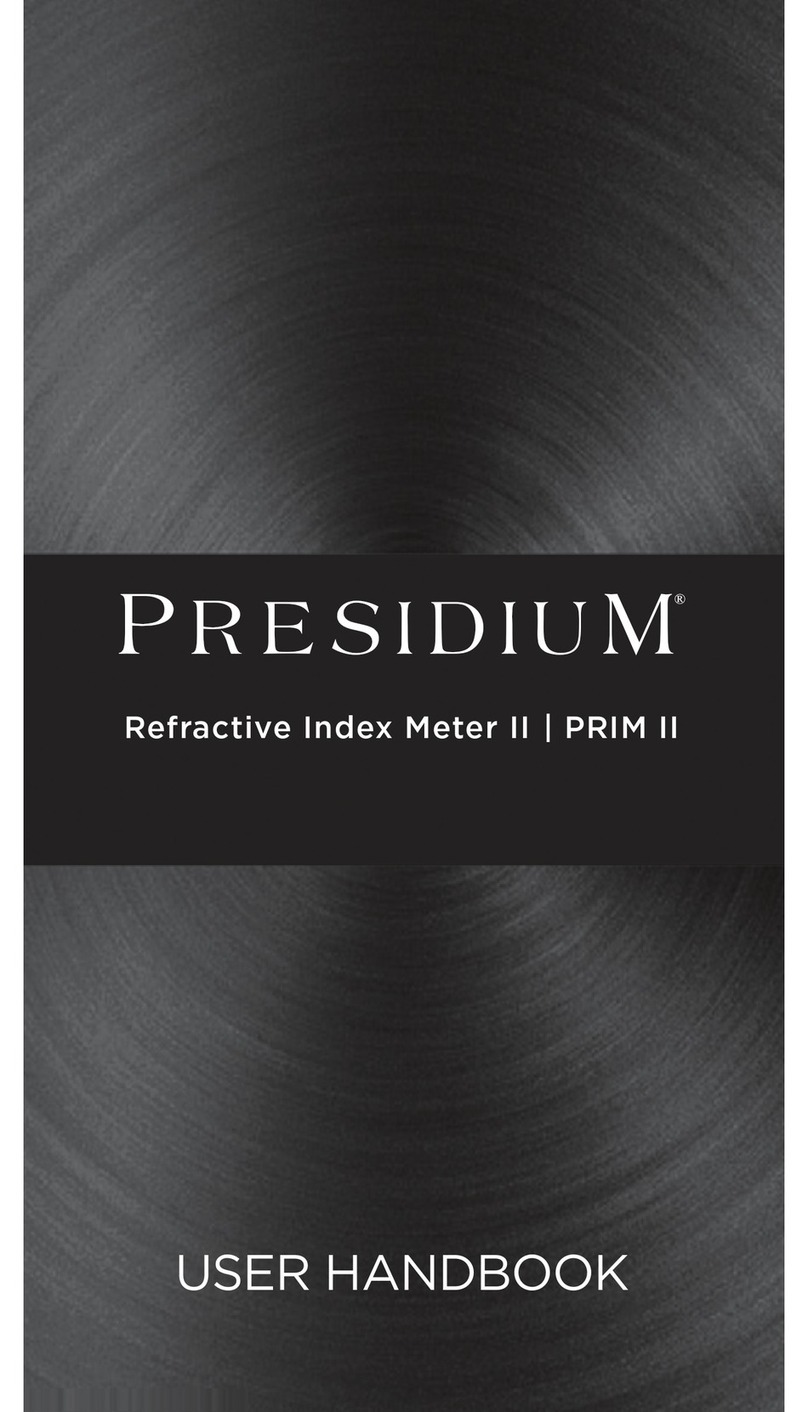
PRESIDIUM
PRESIDIUM Refractive Index Meter II User handbook

ICS Schneider Messtechnik
ICS Schneider Messtechnik GA35 operating instructions
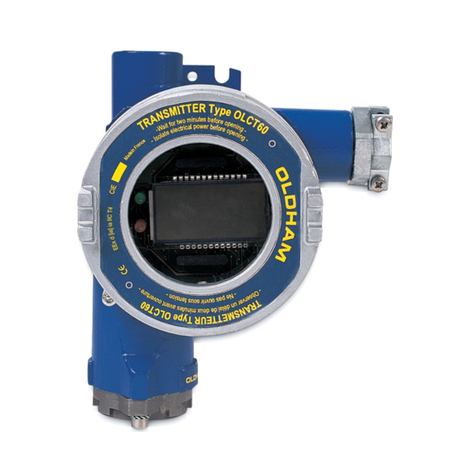
Oldham
Oldham OLCT 60 user manual

